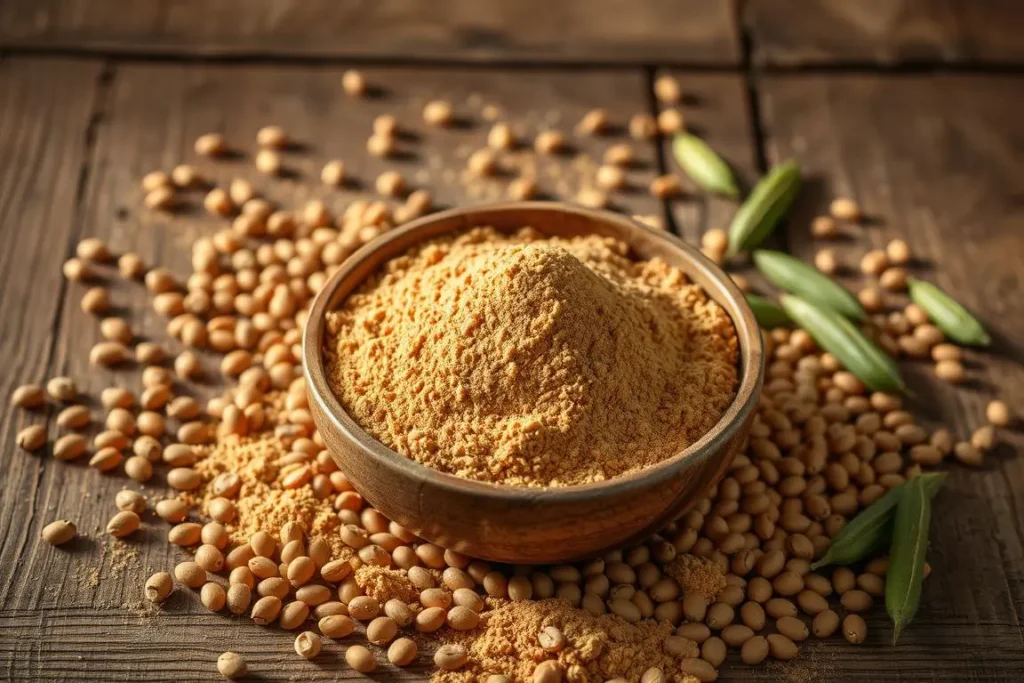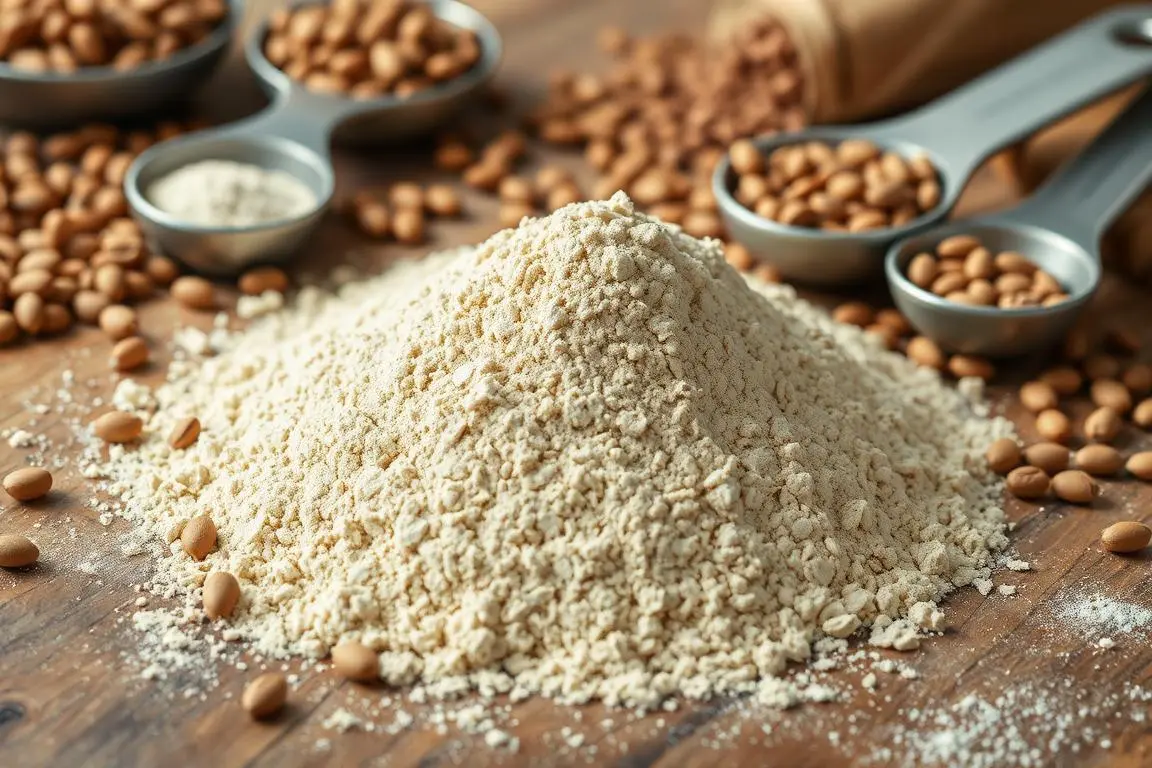Are you looking for a healthy, gluten-free flour option? Lentil flour might be a good choice. It’s become popular, especially among those on special diets. But, you might wonder, is it high in carbs? This guide will look into lentil flour’s nutritional facts, including carbs, and compare it to other flours.
By knowing the facts, you can decide if lentil flour fits into your diet and cooking. It’s packed with nutrients and might be a great addition to your meals.
Key Takeaways
- Lentil flour is a gluten-free, nutrient-dense flour alternative with a moderate carbohydrate content.
- The carb content in lentil flour is lower compared to many other common flours, making it a suitable option for those following low-carb or carb-conscious diets.
- Lentil flour provides a good source of protein, fiber, and essential micronutrients, offering potential health benefits beyond just its carbohydrate profile.
- Proper portion control and recipe adjustments can help maximize the nutritional advantages of incorporating lentil flour into your meals and baked goods.
- Understanding the unique properties of lentil flour can help you unlock its versatility in the kitchen and explore new culinary possibilities.
Understanding Lentil Flour Basics
Lentil flour is becoming more popular as a wheat flour alternative. It’s great for those looking for plant-based proteins, high-fiber foods, and gluten-free options. This ingredient has unique properties that make it stand out.
What Makes Lentil Flour Different
Lentil flour comes from legumes, unlike wheat flour. It’s packed with plant-based proteins and dietary fiber. Its nutty, earthy taste makes it special in cooking. Plus, it’s gluten-free, perfect for those with gluten issues.
Types of Lentils Used for Flour
There are several lentil types used for flour:
- Red lentils
- Brown lentils
- Green lentils
- Black lentils
Each lentil type has its own nutritional benefits and cooking uses. This affects the flour’s final quality.
Processing Methods and Their Impact
How lentil flour is made changes its nutritional value and cooking performance. Here are some common methods:
- Milling: This traditional method grinds whole lentils into a fine powder, keeping most nutrients.
- Sifting: Some makers sift the flour to remove coarse outer husks, making it finer and more even.
- Roasting: Roasting lentils before milling can improve their taste and color. But, it might reduce some nutrients.
Knowing about these processing methods helps you choose the right lentil flour for your cooking and dietary needs.

Is Lentil Flour High in Carbs?
Lentil flour is seen as a healthier choice for those looking for low-carb flour alternatives. But how low in carbs is it really? Let’s explore the carb content of lentil flour and compare it to other flours.
Lentils, the base of lentil flour, have fewer carbs. A 1/4 cup serving of lentil flour has about 11-13 grams of carbs. This is less than all-purpose wheat flour, which has around 24 grams of carbs in the same amount.
This makes lentil flour a better choice for low-carb diets. The carbs in lentils are mostly complex carbs, which digest slowly and affect blood sugar less.
“Lentil flour is a great low-carb flour alternative that can be used in a variety of baked goods and recipes. Its high protein and fiber content also make it a nutritious choice.”
Even though lentil flour isn’t carb-free, it has fewer carbs than other flours. It’s a good option for those watching their carb intake. Remember to keep an eye on portion sizes and your overall diet when using lentil flour.

Complete Nutritional Profile of Lentil Flour
Lentil flour is more than just a source of plant-based proteins. It’s packed with essential nutrients, making it a nutritional powerhouse. Let’s explore the complete nutritional profile of this versatile ingredient.
Protein Content and Quality
Lentil flour is an excellent source of plant-based proteins. It has a lot of high-quality protein, with one serving giving about 10-15 grams. The proteins in lentil flour are complete, meaning they have all the amino acids your body needs.
Fiber and Micronutrients
Lentil flour is also a high-fiber food. A single serving can give up to 10 grams of dietary fiber, which is great for your digestive system. It’s also rich in iron, folate, magnesium, and potassium.
Caloric Content per Serving
One serving of lentil flour nutrition has about 120-150 calories. This makes it a low-calorie option compared to other flours. It’s perfect for those watching their calories but still want a nutrient-rich ingredient.
Adding lentil flour to your diet means you get the benefits of plant-based proteins, high-fiber foods, and many essential nutrients. All in one versatile ingredient.
Comparing Lentil Flour to Other Flour Types
Lentil flour is a top pick for those looking for low-carb and healthy baking options. It’s a great choice because it’s gluten-free and packed with nutrients. This makes it a better option than traditional wheat flour.
Lentil flour has much less carbs than wheat flour. It has more protein and fiber, which helps you feel full longer. This is good for people on low-carb diets or those who want to keep their blood sugar stable.
- Lentil flour: Low in carbs, high in protein and fiber
- Wheat flour: High in carbohydrates, low in protein and fiber
- Almond flour: High in healthy fats, moderate in carbs and protein
- Coconut flour: Low in carbs, high in fiber, moderate in protein
Lentil flour is also gluten-free, which is great for people with gluten issues. This is a big plus compared to wheat flour, which can cause problems for some people.
“Lentil flour is a nutritious and versatile alternative to traditional wheat flour, offering a lower-carb, higher-protein, and gluten-free option for healthy baking.”
Compared to almond and coconut flour, lentil flour has a better mix of nutrients. Almond flour is rich in healthy fats, and coconut flour is low in carbs but high in fiber. Lentil flour, however, has a balanced mix of protein, carbs, and fiber, making it versatile for many recipes.
In summary, lentil flour is a nutritious and versatile choice for baking. Its unique benefits make it a great option for those looking for healthier baking alternatives.
Health Benefits of Using Lentil Flour
Adding lentil flour to your recipes can boost your health. It’s a diabetic-friendly flour and packed with high-fiber foods. These qualities make it a top healthy baking substitute.
Blood Sugar Management
Lentil flour has fewer carbohydrates but more protein and fiber. It’s perfect for keeping blood sugar levels in check. Its slow digestion prevents blood sugar spikes, ideal for diabetic-friendly dishes.
Digestive Health Advantages
Lentil flour is full of dietary fiber, which is great for your digestive system. It helps with regular bowel movements and supports gut health. This makes it a top pick for adding more high-fiber foods to your diet.
Weight Management Benefits
The protein and fiber in lentil flour aid in weight management. It keeps you feeling full, reducing cravings and overeating. Using healthy baking substitutes like lentil flour can help you enjoy treats while working on your weight.
“Lentil flour is a versatile and nutritious ingredient that can significantly improve your overall health and well-being.”
Best Culinary Applications for Lentil Flour
Looking to add more gluten-free flours to your cooking? Lentil flour is a great choice. It’s packed with nutrients and low in carbs. You can use it in many tasty dishes, from baked goods to savory meals.
Lentil flour is perfect for baking. You can replace up to 30% of regular flour in recipes. It adds a nutty flavor that goes well with spices, nuts, and dried fruits. Adding it to your gluten-free baked goods boosts protein and fiber.
Lentil flour is also great as a thickener for sauces, soups, and stews. Just whisk a bit into your favorite dishes for a creamy texture. Its high protein content makes it a great binder for many recipes.
“Lentil flour is a game-changer in the kitchen. It adds nutrition and depth of flavor to both sweet and savory dishes.”
Begin by adding small amounts of lentil flour to your recipes. Gradually increase it as you get used to its taste. With a bit of creativity, lentil flour can open up a world of tasty and healthy dishes.
Storage Tips and Shelf Life
Keeping your lentil flour fresh is important. It helps keep its nutritional value and quality. Here are some tips to store it right:
Proper Storage Methods
- Use an airtight container or resealable bag to keep air and moisture out.
- Store it in a cool, dry spot like a pantry or kitchen cabinet. Avoid direct sunlight and heat.
- For longer storage, refrigerate or freeze it, especially in hot or humid weather.
Signs of Spoilage
Lentil flour can spoil if not stored properly. Look out for these signs to know when to throw it away:
- Off-odor: A musty, rancid smell means it’s gone bad.
- Change in color: Fresh flour is vibrant and even. If it’s discolored or has spots, it’s time to replace it.
- Presence of bugs or weevils: Seeing pests is a clear sign it’s not safe to eat anymore.
By storing it right and watching for spoilage, you keep your lentil flour nutritious. Your healthy baking substitutes will stay fresh and tasty.
Common Mistakes When Using Lentil Flour
Lentil flour is a great choice for those who need gluten-free options. It’s nutritious and can be used in many recipes. But, there are some mistakes to watch out for to get the best results.
One mistake is thinking lentil flour absorbs less liquid. It actually absorbs more than wheat flour. Start by using the same amount of lentil flour as wheat flour. Then, add more liquid until your dough feels right.
Another mistake is not expecting lentil flour to make things dense. Baked goods can feel heavy. To fix this, mix the batter well or use more eggs to add air.
- Overestimating the absorbency of lentil flour and not adjusting liquid ratios accordingly
- Underestimating the dense and heavy texture of lentil flour-based baked goods
- Failing to properly sift or blend the lentil flour before use, leading to uneven texture
- Overlooking the need to adjust cooking times and temperatures when substituting lentil flour for wheat flour
Also, make sure to sift or blend the lentil flour well. This makes your baked goods smooth. And, remember to adjust cooking times and temperatures. Lentil flour needs a bit more time and a lower oven temperature than wheat flour.
By avoiding these mistakes, you can make the most of lentil flour. Enjoy delicious, gluten-free, and healthy baked goods.
Where to Buy and What to Look For
Adding lentil flour to your baking can be a big change for those looking for healthier, gluten-free options. But where do you find it, and what should you look for? Let’s look at the options and what to consider to get the best lentil flour for your cooking.
Quality Indicators
When you’re shopping for lentil flour, pay attention to these key quality signs. They help ensure you get a nutritious and effective product:
- Choose lentil flour that’s finely ground and smooth. Coarse or uneven flour might not work as well in recipes.
- Make sure the flour comes from high-quality, non-GMO lentils. Look for reputable brands.
- Check that the flour is free from any unwanted materials, discoloration, or bad smells. These could mean poor processing or storage.
- Opt for organic lentil flour if you can. It avoids harmful pesticides and preservatives.
Price Considerations
Lentil flour, like other gluten-free flours, might cost a bit more than regular wheat flour. But its nutritional benefits and versatility make it worth it. Here are some tips for comparing prices:
- Bigger packages usually give you more value for your money.
- Health food stores or online shops might charge more. So, shop around to find the best deal.
- Watch for sales, bulk discounts, or subscription deals to save on lentil flour nutrition.
By focusing on quality and price, you can find great healthy baking substitutes. They’ll help make your dishes better with lentil flour’s nutritional perks.
Conclusion
In this guide, we’ve looked into the world of lentil flour. It’s packed with health benefits and can spice up your cooking. Lentil flour is a great choice for those looking for is lentil flour high in carbs?, lentil flour nutrition, and healthy baking substitutes.
It’s great for managing blood sugar, improving digestion, or adding more plant-based foods to your diet. Lentil flour is full of protein, fiber, and vitamins. It can make your favorite dishes healthier.
Keep trying new recipes and ways to use lentil flour. This will help you get the most out of it. With a bit of creativity, you’ll discover delicious and healthy dishes that will please your taste buds and body.
FAQ
Is lentil flour high in carbs?
No, lentil flour is not high in carbs. It’s actually a low-carb flour option. Lentils are low in carbs and high in protein and fiber.
How does the carb content in lentil flour compare to other flours?
Lentil flour has much less carbs than wheat flour. Wheat flour has about 75g of carbs per 100g. Lentil flour has only about 20g of carbs per 100g. This makes lentil flour a good choice for baking and cooking.
What is the nutritional profile of lentil flour?
Lentil flour is packed with plant-based protein, about 25g per 100g. It also has a lot of fiber, about 8g per 100g. Plus, it has important vitamins and minerals like iron, folate, and potassium.
Can lentil flour be used in a low-carb or keto diet?
Yes, lentil flour is great for low-carb or keto diets. Its low net carb content is perfect for baking and cooking without going over your carb limit.
How does lentil flour compare to other gluten-free flours?
Lentil flour has more protein and fiber than almond or coconut flour. It’s a more nutritious and filling option for those on a gluten-free diet.
Are lentils OK on a low-carb diet?
Yes, lentils can fit into a low-carb diet when consumed in moderation. While they contain carbohydrates, their high fiber content reduces their net carb count. For example, a 1/2 cup of cooked lentils has about 20 grams of total carbs but 8 grams of fiber, leaving 12 grams of net carbs. They also provide plant-based protein and essential nutrients.
Which bread has the lowest carbs?
Low-carb bread options include:
- Cloud Bread: 1-2 grams of net carbs per serving, made with eggs and cream cheese.
- Almond Flour Bread: 2-4 grams of net carbs per slice, rich in protein and healthy fats.
- Flaxseed Bread: 1-2 grams of net carbs per slice, high in fiber.
- Coconut Flour Bread: 2-3 grams of net carbs per slice, gluten-free and low-carb.
These options are excellent for keto and low-carb diets.
Is lentil bread healthier than regular bread?
Yes, lentil bread is generally healthier than regular bread due to its higher protein and fiber content. While lentil bread contains 15-20 grams of carbs per slice, it offers more nutrients and has a lower glycemic index than wheat bread. This makes it a better choice for those looking to manage blood sugar or incorporate more plant-based nutrients.
Is lentil bread high in carbs?
Compared to low-carb bread options, lentil bread has moderate to high carbohydrate content. A slice typically contains 15-20 grams of carbs, which is less than regular wheat bread but more than almond or flaxseed bread. Portion control is key for including lentil bread in a low-carb diet.
Key Takeaways
- Lentils can fit into a low-carb diet with proper portion control due to their net carb content.
- Low-carb bread options like almond flour, flaxseed, and cloud bread are ideal for those on keto or carb-conscious diets.
- Lentil bread offers health benefits over regular bread but requires portion mindfulness for low-carb plans.

